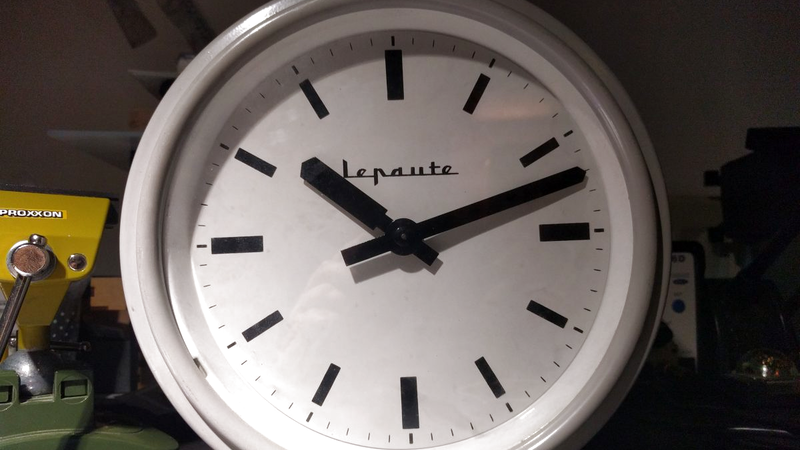Few things are as infuriating as clocks that are not synchronized. It’s frustrating when the clock on the range and the clock on the microwave act like they’re in time zones that are one minute apart. Now picture that same issue over dozens of clocks in a train station, or hundreds in a school or factory. It’s no wonder that slave clocks, which advance on signals from a master clock, were developed.
When a pair of vintage Lepaute slave clocks made their way to [melka], he knew just what to do – build his own master clock to keep the slave on track. This particularly stylish slave clock uses pulses of alternating polarity every 30 seconds and will work on 1.5-volt pulses, which let [melka] meet his design goal of running for a year off a single AA battery. To keep the power needs low, [melka] relies on the RTC to wake up the MSP430 every second to increment a counter. When it hits 30, a pulse is sent to the clock’s motor through an H-bridge; the MCU alternates the polarity of every other pulse to advance the clock.
It’s not immediately clear how the clock is set; we recall the slave clocks in high school rapidly advancing for Daylight Saving adjustments, so we assume [melka] has provided some way of pulsing the clock quickly to set the time. Regardless, it’s a good lesson in low-power design. And be sure to check out this PIC-based master clock replacement, too.
















Nice hack with reusing the old slave clocks. Now it’s too easy to get an “atomic” (i.e. radio controlled) clock movement and swap it out. The ultimate case would be a rubidium frequency standard frequency divided to 60 or 50 HZ and do an amplifier and transformer. Result? An inverter that IS atomic accurate. The site leapsecond.com features a nixie clock rigged as above. But the time nut in question used a caesium beam frequency standard instead!
wow leapsecond.com is amazing, going through his “climbing with atomic clocks” gives a nice quick overview of the logistical challenges in portable atomic timekeeping.
This is a Lavet stepper system very much like every other cheap clock movement made in the last 60 years or so, but those typically tick at 1 Hz instead of 1/30 Hz. The downside to this style is that you can only go one direction and you don’t know where the hands are pointing.
Detecting hand pointing just needs some Hall sensors and 2×1 magnets.
https://www2.pic-upload.de/img/32926750/uhrzeit2.jpg
Oh sure. It’s just that without bolt-ons…
Keeping accurate time has never been easy. Back when most clocks were run by motors running of the 60 (or) 50 Hertz power lines things worked pretty well as long as you didn’t care too much. Over the past few years I’ve gotten interested in time keeping and built an Arduino project that uses a GPS module for pretty accurate time. But this project also measures the 60 Hz line frequency and counts the number of cycles per day. Over the past year or more, I’ve sometimes seen variations of about +/- 8 seconds per day. Watching and recording the line frequency has also shown when nuclear reactors have shut down like during the earthquake in Virginia that damaged the Washington Monument. I also built a master clock system that used IRIG-B for synchronization, but that’s not for everyone. Most of my clocks at home use the WWVB 60kHz signal but ones like on the microwave sure are a pain.
I did the same experiment a while ago (60 Hz vs GPS) and got much the same results. It’s enough that you wouldn’t bother putting a second hand/display on a clock like that.
http://www.instructables.com/id/Science-fair-How-accurate-is-the-AC-line-frequency/
Only spent one year there, but the old Jeff had Seth Thomas clocks in oak cases. Always on time. Gorgeous face and numbers.
Who is the old Jeff?
The clock is set by turning the hands and putting the battery in the holder at just the right moment… I clearly didn’t see it being so cumbersome, I thought it’d be easy work, but it takes me around 10 minutes to set it… If I do a v2, I’ll add a tact switch to send fast pulses for sure.
I made a new master clock for one of the slave clocks at my old University.
Nothing like so power-sipping, though.
https://bodgesoc.blogspot.com/2015/09/clock.html
The clock has no idea where the hands are, so to recover from power cuts it stores the last pulse time to eeprom.
Possibly the most interesting part of the project was the wear-levelling algorithm for the eeprom. I ended up using a fairly simple method good for about 50 years. But a friend managed 98 years of life assuming 100,000 write cycles.